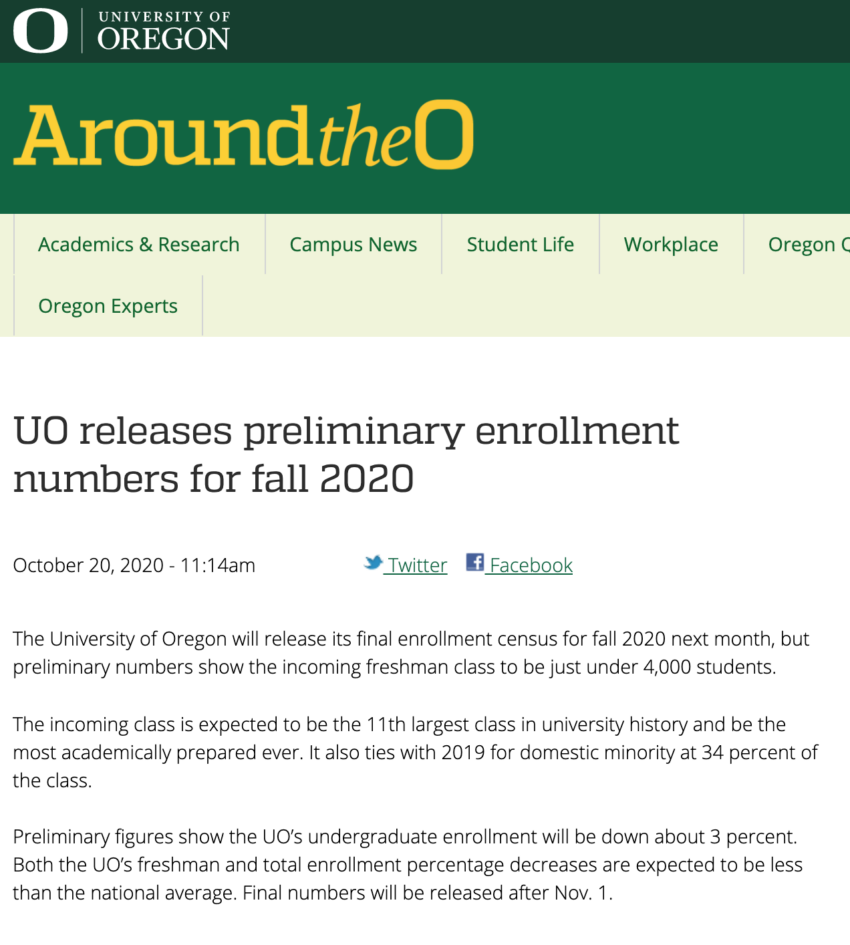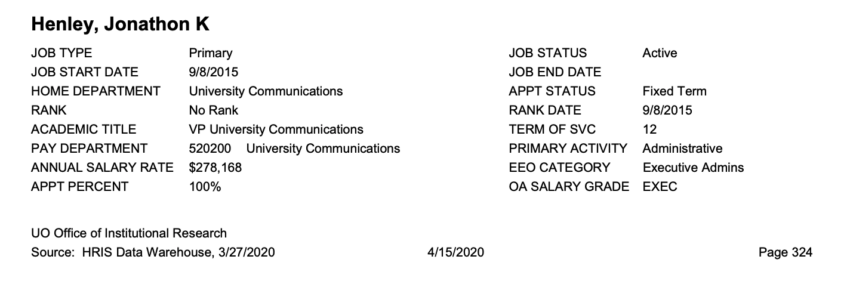Update and Correction:
I have to eat a little crow on this post. A well informed expert at another university asked me if I was sure that I wasn’t confusing “First time entering Freshmen” with “Fall enrollment” of freshman. These can be different because continuing students who enrolled in past years and have <45 credits are still classified as Freshmen for fall enrollment purposes, while First time Freshmen entering with 45 or more credits (say from APs) are classified as sophomores in Fall enrollment. I searched, and found this page on the Registrar’s site giving the “First time entering Freshmen” numbers for UO. It hasn’t been updated since 2017, but it suggests that the First time numbers are typically about 900 students lower than the Fall enrollment numbers.
This means that Around the O’s post was not deceptive, and that the overall enrollment drop in “First time entering Freshmen” is probably much less than 22% – which explains why their prediction of an overall enrollment drop of 3% may well hold up. In any case we’ll find out when IR gets around to updating the 4th week figures, presumably next week.
I apologize for the accusation that Around the O and $285K VP Kyle Henley intentionally tried to mislead anyone with their post. I’ve left my original post below, in case anyone wants to sue me.
10/20/2020: The good news is that total enrollment will only be down 3%. Given this year’s tuition increase, revenue will be pretty flat this year, even assuming most of the freshman we’ve lost are out-of-state.
But the rest of the news from Around the O story today is bad, despite the spin from our $278K VP for Strategic Mis-Communications Kyle Henley:
“The incoming class is expected to be the 11th largest class in university history”
Let’s do the math. Freshman enrollment has been pretty steady at ~5000 a year since 2009. Last year it was 5066. Apparently it will be a bit less than 4000 this year. Let’s call it 3950, and a 22% drop. The average drop for public universities for this year, from the NSCRE, is 13.7%.
Around the O then claims this:
“Both the UO’s freshman and total enrollment percentage decreases are expected to be less than the national average.”
Yeah, if you include community colleges, that might be true. Is that really the right comparison group? Why do you all ways try to deceive us, Kyle? And how can you be so bad at it and still have a $278K job?




As long as they’re also hiding it from whoever has their finger on the pay cut trigger, I’m ok with this.
I am not sure that 3% and 22 % are consistent
say there are 5000,4000,4000,4000 students as fr,so,jr,sr
so 17,000 undergrads
22% loss means 5000 goes to 4000 so now 16,000 undergrads
or a total cut of 6%
yes I know its not that simple, but i expect the reality when the
final numbers are in is likely to be closer to 5% – but that is still good and likely not large enough to trigger pay cuts to start
this term …
this comment above is mine, Dog and I imagine some will do the analysis as to proper comparison.
For example UO and OSU and CU are both located in relatively small communities- but we should not be compared with USC or UW as they are embedded in large communities. I have no idea
if there is a difference in the numbers (yet) but the issue of whether or not we are doing better or worse than proper comparators is a useful exercise to help improve our policies.
Please be sure you read the correction to this post, posted at the top.
so noted, counting is always hard, but I still think the 3% number
will turn out to be too optimistic
Hopefully UO continues to enroll less out-of-state and international students and more in-state students going forward. Obviously this depends on the state subsidy but I think it is in the best interest for everyone.
I don’t see how fewer out of state students is advantageous to anyone. They are not limiting the in state enrollment. They are subsidizing it. Why then do you object to them?
How are out of state students subsidizing in state students when this is occurring?
https://www.oregonlive.com/education/2018/05/oregon_denied_financial_aid_to.html
That article is about a state program that is poorly funded but has no connection that I know of with out of state tuition income. The latter does subsidize Oregon students whether in the form of increased money for internal UO financial aid, enriched academic programs and student services, or more likely some combination of all of these.
When setting the base tuition level, the university calculates costs minus state support and then sets tuition levels to cover that. Clearly, if the entire enrollment paid the in-state level of tuition, tuition would have to increase. Is there any argument that is not the case?
Your article talks about how Oregon doesn’t meet the need of some students who can’t pay for even this subsidized level of tuition…image how many would be written about with in-state tuition being 50% higher because no out-of-state students were admitted.
It seems neither of you understands the article, nor the claims of out of state student subsidization. The bulk of qualified in state students who need actual state help, i.e. money, to attend their own unis, are being denied those funds. They cannot receive any of the supposed benefits of phantom out of state subsidization if they can’t get on campus. The claim that without those out of staters tuition would be ludicrioius, rather than current ridiculous levels, ignores the poor financial management of administrations in controlling costs. If you bother to look at historical flagship enrollment, it will underscore just how nonsensical the claims of out of state subsidization have become. Oregoninans are deliberately being crowded out of their own unis in order to make way for those that pay more.
Straight up, the only reason the flaghsip has gone after the out of state students is because they pay more, take out bigger loans, which are the collateral for the construction bonds. Nothing else. If either of your thinking is representative of current university thinking, then the future is indeed bleak…
Oh, I agree. In a world where UO is supported by state appropriations and administrators run a tight ship and the campus doesn’t need any new buildings then tuition could be paid by busking on Broadway Friday nights and we wouldn’t need any high-tuition outsiders to help keep tuition costs low for Oregon students and none of them would need additional financial aid.
It seems we agree “Oregonians are deliberately being crowded out of their own unis in order to make way for those that pay more.” Your point is (I think) that it isn’t subsidizing tuition but rather allowing wanton spending and unjustifiable salaries. My point is that unless there is an actual plan to cut those, the out of state student tuition is directly causing lower tuition for in-state students and I term that a subsidy.
charlie, the future may well be bleak, but with all due respect, what you say makes no sense that I can discern. How would dumping the out of state students and their money improve the situation of “state help” for poor Oregon students? I don’t see how. Maybe you think without the out of staters, the state would pony up more money for Oregonians? I guarantee, that kind of thinking prevailed for decades, and the state support just lagged. If anything, the state has come up with more money in recent years.
And what is the evidence that “Oregonians are deliberately being crowded out”?
The state’s research flagship started planning a much-needed classroom building about a decade back; the Learning Innovation Center opened five years ago. The only way the project – a general classroom building, not tied to a school or pooled research funding streams – was able to go forward to completion was because it could be paid for – and the security for those bond payments was set forth as, yep, out-of-state tuition revenues.
I think this link has the previous enrollment figures for new entrants: https://ir.uoregon.edu/cds
2018
Actual: 4,168
https://ir.uoregon.edu/sites/ir1.uoregon.edu/files/CDS_2018-2019.pdf
Preliminary: 4,203
https://around.uoregon.edu/content/uo-celebrates-growth-new-students-and-pathway-participants
2019
Actual: 4,525
https://ir.uoregon.edu/sites/ir1.uoregon.edu/files/CDS_2019-2020.pdf
Preliminary: 4,558
https://around.uoregon.edu/content/uos-incoming-class-2023-one-record-books
Hopefully UO’s enrollment mix has fewer internationals and out-of-staters going forward.
I hope he does sue you. Not because you can’t offer a useful service providing information to counter UO spin, but because you consistently misread – or in many cases don’t actually bother to read – anything that doesn’t fit your favorite narratives. You also almost always chose to personalize this misrepresentation which is a dangerous, and ultimately unproductive, way to play the game you so like to play.